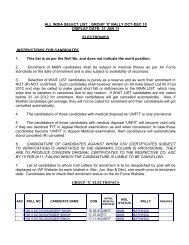Create successful ePaper yourself
Turn your PDF publications into a flip-book with our unique Google optimized e-Paper software.
What is safety culture Who and what<br />
we are, what we find important and<br />
how we go about doing it correctly, is<br />
called Safety Culture. The possession of a safety<br />
management system, no matter how thorough<br />
and systematic it may be, is not sufficient to<br />
guarantee sustained safety performance. To<br />
proceed further it is necessary to develop cultures<br />
that support higher process such as ‘thinking the<br />
unthinkable’ and being highly motivated to be<br />
safe, even when there seem to be no obvious<br />
reasons to do this. But the challenging part here<br />
is of creating a healthy safety culture and keeping<br />
it alive.<br />
We need to adopt a safety culture and<br />
refine it continuously to achieve hole-proof safe<br />
environment around. But it is natural human<br />
behaviour to get used to a particular set of<br />
conditions or environment and resist change.<br />
You can easily understand this trait if you happen<br />
to play golf. When you start the game, you learn<br />
a particular swing and continue to practise.<br />
After years of game, you may be advised by a<br />
professional to adopt a change in your technique<br />
to get a few extra yards. That is the most difficult<br />
time, wherein you are in a period of transition.<br />
You feel like giving up the game because you<br />
are not able to train yourself with respect to that<br />
technique. But it is only through your patience<br />
and belief that you can overcome this situation.<br />
On the same lines, we continuously need to<br />
upgrade our safety culture in order to achieve<br />
few extra yards of safe environment, inspite of<br />
difficulties we are likely to face.<br />
Recently, I read about five types of safety<br />
culture, that are enumerated as follows:-<br />
We care less about safety than about not<br />
being caught.<br />
We look for fixes to accidents and incidents<br />
after they happen.<br />
We have systems in place to manage hazards<br />
(however the system is applied mechanically).<br />
We follow the procedure but do not necessarily<br />
believe these procedures are critically important.<br />
We have systems in place and we genuinely<br />
belief that safety is genuinely worthwhile.<br />
Safety behaviour is fully integrated into<br />
everything we do.<br />
We may decide on our own in which category<br />
our safety culture falls. But whatever level it may<br />
be, the aim is to achieve the fifth level where safety<br />
behaviour is fully integrated into everything we<br />
do.<br />
The underlying reason why cultural change<br />
often fails to succeed is that the new situation is<br />
unknown to the participants. We often believe<br />
that the current situation is as good as it gets and<br />
there is little scope to change.<br />
Change agents are like golf professionals.<br />
They can help develop a person’s game, but they<br />
can’t play it for them. The greatest single barrier<br />
to achieve success however, is the belief that it is<br />
too difficult. On the contrary, in the long term it is<br />
more difficult and dangerous not to!<br />
- Flt Lt UB Singh<br />
INDIAN AIR FORCE 2 0 1 2 J u n e Aerospace Safety 17

















